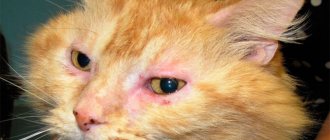Diseases of the bones and periosteal tissues of domestic animals include osteomyelitis. Pathology develops when pathogenic microorganisms penetrate bone tissue. The infectious-inflammatory process affects not only the red bone marrow, but also osteocytes. Osteomyelitis, as a serious illness, requires immediate professional help due to the risk of sepsis developing in a sick pet.
Reasons for the development of the disease
The inflammatory process in bone structures in domestic cats can develop under the influence of the following reasons and factors: Violation of bone integrity due to fractures. Most often, open fractures lead to the development of the disease.
- Complications resulting from orthopedic surgery . The surgical method of treating fractures and other injuries of bone structures, especially with the use of osteosynthesis, is often associated with the risk of infection of bones and periosteal tissues. Pathogenic microorganisms can enter the bone if the surgeon does not comply with the rules of asepsis and antisepsis or poor postoperative care.
- Various types of wounds affecting bones: gunshot, bitten, penetrating. Violation of bone integrity and penetration of pathogenic microbes leads to the development of an infectious-inflammatory process.
- Chronic diseases : gingivitis, periodontal disease, pulpitis of molars often lead to the fact that the infectious process is transferred to the jaw, and inflammation of the bone elements and periosteal tissues develops. Pathologies such as rhinitis, otitis media, paronychia (inflammation of the soft tissues around the claw), and pyonychia (purulent inflammation of the tissues around the claw) can lead to osteomyelitis.
- Hematogenous infectious diseases , including sepsis. Viruses and bacteria circulating in the bloodstream can enter bone structures, which leads to their inflammation when local defense mechanisms are disrupted.
- The cause of osteomyelitis in domestic cats is often an autoimmune malfunction in the body.
Veterinary practice shows that in approximately half of cases the causative agent of the infectious process in bone structures is staphylococcus . In addition to them, aerobic gram-negative bacteria and anaerobes, for example Clostridium spp, Peptostreptococcus spp, are often involved in the purulent-inflammatory mechanism of the disease. There are cases when pathogenic fungi act as the causative agent of the disease: Coccidioides immitis, Blastomyces dermatitidis, Aspergillus spp.
We recommend reading about rickets in cats. You will learn about the causes of the disease, provoking factors, symptoms, diagnostic methods, treatment at home and in a veterinary hospital. And here is more information about the symptoms and treatment of phlegmon in cats.
Factors contributing to the development of osteomyelitis also include:
- diabetes mellitus (due to the development of diabetic ulcers);
- liver and kidney diseases;
- low animal resistance, weak immune response;
- advanced age;
- oncological diseases.
Veterinary specialists also include vitamin deficiencies, exhaustion and hypothermia of the animal as risk factors. The trigger for the disease may be a burn or frostbite.
What kind of disease is this?
This is the name of the process of infectious-inflammatory nature that affects the red bone marrow. Then the inflammation spreads to the bone tissue itself. If the pathology progresses greatly, it can even lead to complete destruction of the bone. The information accumulated by scientists over several decades does not allow us to identify any specific causative agent of this disease. Most often, its role is played by various types of pyogenic cocci, but there are cases when osteomyelitis developed due to the action of ordinary Escherichia coli. Sometimes the “initiator” is Staphylococcus aureus. Simply put, there are many pathogens for this disease.
We became acquainted with the direct culprits of the problems. But where do they get into the bone, what is the very cause of this disease? As a rule, the problem in this case lies in the presence of some kind of inflammatory disease near the site of bone damage. Thus, osteomyelitis of the jaw in cats may well develop against the background of advanced gingivitis or periodontal disease. It can also be a consequence of incipient sepsis, if inappropriate antibiotics (not titrated for sensitivity) were used to treat the latter, when some of the microorganisms remained in the body. Of course, serious mechanical injuries will also play a negative role.
So, with fractures of the femur, if the cat did not receive qualified veterinary care in time, osteomyelitis will develop with a high degree of probability. A surgeon who did not properly observe the rules of asepsis and antisepsis can also make a contribution. Thus, cases of osteomyelitis often occur when a pin is prosthetized into the femur. However, sometimes this disease is autoimmune in nature, when the body simply does not perceive this very pin and begins to reject it.
Symptoms of osteomyelitis in cats
First of all, the owner will pay attention to the deterioration of the pet’s general condition, which manifests itself as follows:
- Appetite decreases and disappears completely. The cat is quickly exhausted.
- The sick animal rapidly weakens, does not get up, does not move.
- The state is sluggish, apathetic. The cat stops playing and responding to the name.
- Active movements in the joint and palpation of the affected area bring pain to the animal.
- When walking, there is pronounced lameness and pain - the cat meows and screams.
- Experiencing pain, the animal constantly licks the affected areas.
- The overall body temperature increases.
- The cat is breathing heavily and frequently, and there is tachycardia.
- There is an increase and pain in the regional lymph nodes.
As for the symptoms in the area of inflammation, the owner of a sick pet can observe the following clinical picture:
- The tissue at the site of the lesion swells, turns red, and eventually becomes necrotic.
- In the source of inflammation, palpation reveals an area that is hot to the touch.
- At the site of the wounds, purulent wounds and fistulas with a large amount of discharged purulent exudate may be observed.
With osteomyelitis of the jaw, the cat has no appetite, and abscess formation is observed. From the fistula, pus can be released into the oral cavity or outward from the jaw. There is an increase in the retropharyngeal lymphatic vessels.
Severe osteomyelitis requires immediate, highly qualified veterinary care.
Clinical signs
What symptoms should you pay attention to? From the very beginning of the disease, a sharp change in the general condition of the animal is recorded. Naturally, in the direction of its sharp deterioration. The animal's general body temperature quickly rises, lethargy is registered, food refusal occurs, and pain appears in the affected area. If osteomyelitis affects a limb, then the cat falls on it when walking, meowing in pain. In principle, most often the cat generally prefers to stay in place and refuses food. She gets up only to drink water, and she laps it up a lot and greedily. The photo shows how emaciated these cats are. The local temperature is also very high; when you palpate the sore paw, the animal becomes hoarse and meows strained in pain. If by this point the cat has not received any medical help, it may die from sepsis. In the case when she has a sufficiently powerful immune system, numerous fistulas form, from which viscous, thick pus is constantly released.
Important! Take a closer look at this pus: if it contains drops of pus and pieces of bone, the process has gone very far, the cat needs to be taken to the vet immediately!
Stages of disease development
In domestic animals, the inflammatory process occurs only in the bone marrow rarely. Most often, the jaws, ribs, femur and chest bones are susceptible to purulent inflammation. The risk group includes street and malnourished animals. Young individuals suffer from osteomyelitis less often.
Veterinarians distinguish between chronic and acute forms of the disease. In both cases, the pathogenesis of the disease has similar features. Initially, there is a disruption in the blood supply to the bone structures of the body as a result of spasm of blood vessels for various reasons. In the first stages, aseptic inflammation develops, which is characterized by swelling, impaired blood supply and oxygen starvation of tissues.
Chronic post-traumatic osteomyelitis. There is irregular proliferation of the periosteum and absence of bridging callus, as well as poor rotation of the fracture.
When pathogenic microflora enters the bone marrow canal, intraosseous pressure increases. This leads to the spread of purulent exudate into the periosteum. The process is accompanied by severe pain. Melting of the periosteum under the influence of pathogenic microorganisms provokes the formation of a fistula. The disease becomes chronic.
The most unfavorable for a sick animal is the acute form of osteomyelitis, when purulent inflammation spreads to the entire bone. The resulting periosteal phlegmon leads to the melting of the periosteum, bone, and muscle tissue. In the bone itself, sequestra (cavities) are formed, filled with purulent contents.
Osteomyelitis
When the purulent process generalizes, pathogenic microorganisms and their toxins spread from the source of inflammation throughout the body. Endotoxin causes not only a rise in temperature, but also a sharp drop in blood pressure with the development of irreversible septic shock. The development of pathology in this scenario leads to death.
Description of the disease
Osteomyelitis in animals is a serious disease. In cats, this pathology is not diagnosed very often, but if the veterinarian diagnoses osteomyelitis, then such a diagnosis causes quite a lot of trouble.
In osteomyelitis, inflammatory phenomena affect, after the red bone marrow, the endostat, periosteal tissues and compact substance. With further progression of the pathology, complete bone destruction may occur.
The disease affects cats at any age, targeting weakened and emaciated animals. Most often, osteomyelitis affects the metadiaphyseal elements of long bones, for example, the pads and phalanges of the cat's paws.
Osteomyelitis most often affects the phalanges and toe pads of cats.
There are three main stages in the clinical course of this disease:
- acute course of the disease with diffuse damage and the development of sepsis;
- chronic – develops from the acute phase, characterized by a localized course of the disease with the formation of fistulas;
- primary chronic – a borderline state between the first and second phases.
Animal diagnostic methods
In veterinary practice, the following examination methods are used to make a diagnosis of osteomyelitis:
- Clinical examination of the animal with palpation of the affected areas.
- General and biochemical blood test. With the disease, there is an increase in the number of lymphocytes, band leukocytosis. There is an increase in calcium levels against the background of a decrease in phosphorus, a shift in the acid-base balance towards acidosis.
- X-ray examination.
- Multislice computed tomography.
- Bacteriological culture.
Osteomyelitis of the femur in a cat (shown by white and black arrows).
There is also a pin in the femur that was used to repair the fracture. The main diagnostic method is radiographic examination of bone structures and periosteal tissues. The method makes it possible to identify foci of necrosis in bone tissue, destruction of the periosteum and bone in the form of oval foci of irregular shape, and to assess the scale of the inflammatory process.
Etiology and pathogenesis
In pets, inflammation occurs exclusively in the bone marrow infrequently. Often it affects the ribs, chest and femur, and jaw. The disease is most often diagnosed in malnourished cats. The disease can be chronic and acute; the pathogenesis of these forms is similar. First of all, there is a disruption in the flow of blood to the bone structures due to vascular spasm. Aseptic inflammation occurs, which causes swelling and oxygen starvation of cells. When microorganisms find themselves in the bone marrow canal, pressure increases there, as a result of which pus enters the periosteum, causing severe pain. The melting of this connective tissue film causes the appearance of a fistula, which rots, and the transition of the disease to the chronic stage.
The greatest danger for a cat is the acute form of osteomyelitis, during which the inflammatory process spreads throughout the bone. From the source of inflammation, bacteria and their metabolic products can spread throughout the body along with the blood. In such a situation, there is a strong increase in the pet’s body temperature, as well as a serious decrease in blood pressure. This course of the disease causes the death of the cat.
The following factors can provoke osteomyelitis of the jaw, tail and other bones:
The impetus for the development of this disease can be a fracture.
- fractures;
- postoperative consequences of intervention in the musculoskeletal system;
- wounds that affected a solid organ;
- chronic diseases;
- infectious pathologies;
- autoimmune disorder of the body.
Return to contents
Treatment in the clinic
Treatment of such a serious illness as osteomyelitis requires high professionalism from a veterinary specialist. First of all, the animal is prescribed powerful antibacterial drugs, including sulfonamides. Antibiotics are selected taking into account sensitivity determination by bacterial culture.
Insertion of an intraosseous catheter
Antimicrobial drugs are used in the form of intramuscular and intravenous injections. Local administration of antibiotics using a novocaine solution is no less effective. Such blockades make it possible to stop a purulent focus in the early stages of osteomyelitis, delivering an antibacterial agent directly to the affected tissue.
Intraosseous injections are carried out strictly in a specialized institution. The course includes 7 - 10 such injections. In this case, the needle inserted during the first procedure remains for the entire duration of the antibacterial course.
According to indications, a veterinary specialist will perform surgical cleansing of the wound with removal of necrotic tissue and damaged bone (sequestrotomy). The periosteum is removed along with the soft tissues. During the operation, resection of the damaged bone marrow and formed bone sequesters is performed. A plaster cast is usually applied to the operated area.
If the entire bone is affected, the surgeon recommends that the owner undergo amputation of the limb or prosthetics for the pet.
In the postoperative period, in addition to an aggressive course of antibacterial drugs, physiotherapy methods are also used in veterinary practice. The use of ozokerite and paraffin applications, UHF promotes the speedy recovery of the animal. Procedures are prescribed during the period of attenuation of acute inflammation.
In cases of intoxication, plasma transfusions, intravenous injections of glucose, Ringer's solution, etc. are prescribed.
Osteomyelitis greatly depletes the animal’s body; the level of vitamins and minerals in the blood drops sharply. In this regard, ascorbic acid, B vitamins, and vitamin A are used in complex therapy of the disease.
Home care plays an important role in treating the disease. The main task of the owner is to ensure complete rest and limit mobility. Treatment of postoperative wounds should be carried out in compliance with the rules of asepsis and antisepsis. Particular attention is paid to the prevention of bedsores. The animal is provided with a balanced diet; if necessary, the attending physician will prescribe vitamin and mineral supplements.
To learn how intraosseous administration of a drug for osteomyelitis is carried out, watch this video:
Diagnostic measures
If cat owners suspect that their pets are developing osteomyelitis, it is important to contact a veterinary clinic as soon as possible. First of all, the veterinarian will conduct a survey, during which he will find out how long ago the animal noticed unwanted symptoms and whether any injuries occurred. Then the doctor begins a clinical examination of the pet and palpating the affected areas of the body. Next, the cat is sent for biochemical and general blood tests. According to the results of the analysis, you can notice an increase in the level of lymphocytes and calcium, a decrease in phosphorus.
The disease is often diagnosed by radiography.
Then radiography is performed, which is considered the most effective method to detect osteomyelitis. Using this study, it is possible to detect foci of necrosis that are located in bone tissue, as well as destruction of bones and periosteum. If required, the cat is sent for multislice computed tomography. Bacteriological culture completes the diagnostic measures.
Forecast for cats
The prognosis for osteomyelitis in domestic cats is cautious or questionable. In the case of a chronic course of the disease and initiation of therapy in the early stages of the process, the prognosis is usually cautious. With the development of a generalized infection, the outcome for the animal can be the most unfavorable, even fatal.
We recommend reading about paraanal inflammation in cats. You will learn about the functions of the paraanal glands, the causes and symptoms of inflammation, treatment and prevention. And here is more information about the treatment of otitis media in cats.
Forecast and preventive measures
The disease is considered serious in cats and has an uncertain prognosis. If the pathology occurs in a chronic stage, the diagnosis was made on time and the correct treatment was prescribed, veterinarians make a cautious prognosis, taking into account the individual characteristics of the pet, the presence of concomitant diseases and age. When there is a generalization of the purulent process from the source of inflammation through the blood, in such a situation the scenario is unfavorable. The situation could lead to the death of the cat.
If we talk about preventive measures, then the owner can prevent the development of osteomyelitis in a cat by adhering to simple principles. First of all, it is important to exclude situations that are traumatic for the pet. You should not let your cat go outside alone, as the likelihood of negative scenarios developing there is much higher than at home.
If it was not possible to protect the cat from harm, it is important to provide assistance to him as soon as possible and take him to the clinic. An important preventive measure that will reduce the likelihood of osteomyelitis is systematic vaccination, which makes it possible to protect your pet from infectious pathologies. The owner will also need to monitor the animal’s diet. It is important to include foods that are rich in vitamins and microelements in the menu. It is recommended to give your cat lean meat, vegetables, cereals, and eggs. Fermented milk products and boiled fish are also acceptable, but in limited quantities. Once a year you need to give vitamin and mineral complexes, which are sold in pharmacy chains. They help strengthen the immune system.
Diseases of the bones and periosteal tissues of domestic animals include osteomyelitis. Pathology develops when pathogenic microorganisms penetrate bone tissue. The infectious-inflammatory process affects not only the red bone marrow, but also osteocytes. Osteomyelitis, as a serious illness, requires immediate professional help due to the risk of sepsis developing in a sick pet.











